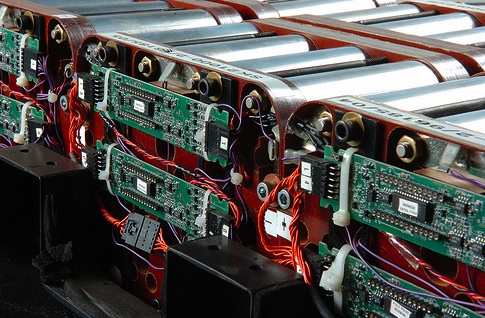New bill would mandate energy storage for California power grid

 A new bill in the California Assembly would mandate that electricity utilities store 2.25% of peak demand load by 2014 and 5% by 2020. AB 2514 was introduced by Attorney General Jerry Brown and Assemblymember Nancy Skinner. If it passes, energy storage will become common in California and this will help create a smart grid.
A new bill in the California Assembly would mandate that electricity utilities store 2.25% of peak demand load by 2014 and 5% by 2020. AB 2514 was introduced by Attorney General Jerry Brown and Assemblymember Nancy Skinner. If it passes, energy storage will become common in California and this will help create a smart grid.
Our current grid, both state-wide and national, is old, creaky, and dumb. The amount of power produced must always match the power consumed because there’s no place to store extra energy. Conversely, a sudden surge in demand now means generating plants must act instantly.
With energy storage, those problems start to go away. A surge in demand can be met by using stored power. This could be seriously useful on those hot summer afternoons when everyone’s air conditioner is going. Some of that demand could be met by power that was generated the night before and stored.
Also, renewable energy sources like wind and solar are by definition variable. This can put strain on our existing aging grid. But with stored power, such energy can be generated anytime and used as needed. This can help towns like Presidio, TX that have just one transmission line which sometimes goes down, causing blackouts. They are about to go online with a massive 4 MW battery that can power the entire town for several hours.
Imagine what the benefits would be if energy storage was done in thousands of locations in California. There would be far fewer blackouts, and electricity rates would probably be lower because power could be generated during off hours when it’s cheaper, then stored for later use.
The Electricity Storage Association has an explanation of energy storage technologies (pumped hydro, compressed air, flywheels, and multiple types of batteries) with descriptions of each as well as comparison charts. To their list, I would also add solar thermal.
Pumped storage is the most widely used method. Water is pumped from a lower reservoir to a higher one during off-hours when power is cheaper. The water is released when power is needed. It’s not particularly efficient and may in fact use more power than it produces. But the stored power can be sold for a higher price.
Compressed air is stored underground, again during off-peak hours, to be used when needed to power gas turbines. Since such natural gas-powered turbines ordinarily use considerable power to compress air while making energy, this results in a system that uses 40% less gas.
Flywheels store power as rotational energy. Their rotors spin extremely fast, several hundred times a second. They have a long life, require little maintenance, and are already used in UPS systems and by cell phone companies.
Batteries can store power too, obviously. NaS are highly efficient, with high power and energy densities. Metal-Air also have high energy density, are cheap and environmentally benign. But re-charging them is difficult. The old stand-by of Lead-Acid batteries is generally not practical for commercial power storage as they have a short life. However, a few sites use them. Research continues on ever more exotic batteries and capacitors.
Solar thermal uses the heat of the sun to directly run turbines. Excess heat is stored as steam, or in molten salt or graphite, allowing electricity to be generated at night. Older versions of solar thermal require large amounts of outside water. However, new designs convert the steam back to water and reuse it. This is important for solar thermal plants in deserts where water is already scarce.
The California grid needs energy storage, and it needs it now. Our current system is like having gas stations that don’t have storage tanks, that require drivers to wait for gas tankers and fuel up directly from them, rather than having gasoline stored for use when they need to re-fill.
A system like that would be crazy for re-fueling automobiles, but that’s what our electricity grid is like now. It has no place to put energy for future use. A comprehensive system of stored energy will solve that.



